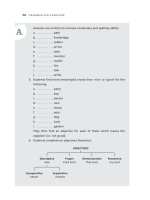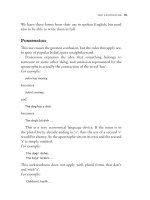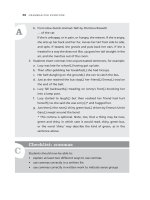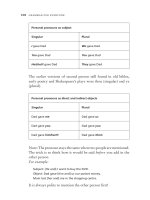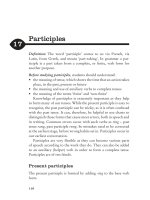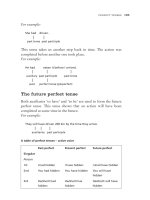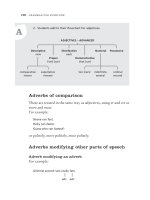Arduino Microcontroller Processing for Everyone Part I
Bạn đang xem bản rút gọn của tài liệu. Xem và tải ngay bản đầy đủ của tài liệu tại đây (1.12 MB, 114 trang )
Arduino Microcontroller
Processing for Everyone!
Part I
Synthesis Lectures on Digital
Circuits and Systems
Editor
Mitchell A. Thornton, Southern Methodist University
The Synthesis Lectures on Digital Circuits and Systems series is comprised of 50- to 100-page
books targeted for audience members with a wide-ranging background. The Lectures include topics
that are of interest to students, professionals, and researchers in the area of design and analysis of
digital circuits and systems. Each Lecture is self-contained and focuses on the background
information required to understand the subject matter and practical case studies that illustrate
applications. The format of a Lecture is structured such that each will be devoted to a specific topic
in digital circuits and systems rather than a larger overview of several topics such as that found in a
comprehensive handbook. The Lectures cover both well-established areas as well as newly
developed or emerging material in digital circuits and systems design and analysis.
Arduino Microcontroller: Processing for Everyone! Part I
Steven F. Barrett
2010
Digital System Verification: A Combined Formal Methods and Simulation Framework
Lun Li and Mitchell A. Thornton
2010
Progress in Applications of Boolean Functions
Tsutomu Sasao and Jon T. Butler
2009
Embedded Systems Design with the Atmel AVR Microcontroller: Part II
Steven F. Barrett
2009
Embedded Systems Design with the Atmel AVR Microcontroller: Part I
Steven F. Barrett
2009
Embedded Systems Interfacing for Engineers using the Freescale HCS08 Microcontroller
II: Digital and Analog Hardware Interfacing
Douglas H. Summerville
2009
iv
Designing Asynchronous Circuits using NULL Convention Logic (NCL)
Scott C. Smith and Jia Di
2009
Embedded Systems Interfacing for Engineers using the Freescale HCS08 Microcontroller
I: Assembly Language Programming
Douglas H.Summerville
2009
Developing Embedded Software using DaVinci & OMAP Technology
B.I. (Raj) Pawate
2009
Mismatch and Noise in Modern IC Processes
Andrew Marshall
2009
Asynchronous Sequential Machine Design and Analysis: A Comprehensive Development
of the Design and Analysis of Clock-Independent State Machines and Systems
Richard F. Tinder
2009
An Introduction to Logic Circuit Testing
Parag K. Lala
2008
Pragmatic Power
William J. Eccles
2008
Multiple Valued Logic: Concepts and Representations
D. Michael Miller and Mitchell A. Thornton
2007
Finite State Machine Datapath Design, Optimization, and Implementation
Justin Davis and Robert Reese
2007
Atmel AVR Microcontroller Primer: Programming and Interfacing
Steven F. Barrett and Daniel J. Pack
2007
Pragmatic Logic
William J. Eccles
2007
v
PSpice for Filters and Transmission Lines
Paul Tobin
2007
PSpice for Digital Signal Processing
Paul Tobin
2007
PSpice for Analog Communications Engineering
Paul Tobin
2007
PSpice for Digital Communications Engineering
Paul Tobin
2007
PSpice for Circuit Theory and Electronic Devices
Paul Tobin
2007
Pragmatic Circuits: DC and Time Domain
William J. Eccles
2006
Pragmatic Circuits: Frequency Domain
William J. Eccles
2006
Pragmatic Circuits: Signals and Filters
William J. Eccles
2006
High-Speed Digital System Design
Justin Davis
2006
Introduction to Logic Synthesis using Verilog HDL
Robert B.Reese and Mitchell A.Thornton
2006
Microcontrollers Fundamentals for Engineers and Scientists
Steven F. Barrett and Daniel J. Pack
2006
Copyright © 2010 by Morgan & Claypool
All rights reserved. No part of this publication may be reproduced, stored in a retrieval system, or transmitted in
any form or by any means—electronic, mechanical, photocopy, recording, or any other except for brief quotations in
printed reviews, without the prior permission of the publisher.
Arduino Microcontroller: Processing for Everyone! Part I
Steven F. Barrett
www.morganclaypool.com
ISBN: 9781608454372
ISBN: 9781608454389
paperback
ebook
DOI 10.2200/S00280ED1V01Y201005DCS028
A Publication in the Morgan & Claypool Publishers series
SYNTHESIS LECTURES ON DIGITAL CIRCUITS AND SYSTEMS
Lecture #28
Series Editor: Mitchell A. Thornton, Southern Methodist University
Series ISSN
Synthesis Lectures on Digital Circuits and Systems
Print 1932-3166 Electronic 1932-3174
Arduino Microcontroller
Processing for Everyone!
Part I
Steven F. Barrett
University of Wyoming, Laramie, WY
SYNTHESIS LECTURES ON DIGITAL CIRCUITS AND SYSTEMS #28
M
&C
Morgan
& cLaypool publishers
ABSTRACT
This book is about the Arduino microcontroller and the Arduino concept. The visionary Arduino
team of Massimo Banzi, David Cuartielles,Tom Igoe, Gianluca Martino, and David Mellis launched
a new innovation in microcontroller hardware in 2005, the concept of open source hardware. Their
approach was to openly share details of microcontroller-based hardware design platforms to stimulate
the sharing of ideas and promote innovation. This concept has been popular in the software world
for many years. This book is intended for a wide variety of audiences including students of the fine
arts, middle and senior high school students, engineering design students, and practicing scientists
and engineers. To meet this wide audience, the book has been divided into sections to satisfy the
need of each reader. The book contains many software and hardware examples to assist the reader in
developing a wide variety of systems. For the examples, the Arduino Duemilanove and the Atmel
ATmega328 is employed as the target processor.
KEYWORDS
Arduino microcontroller, Arduino Duemilanove, Atmel microcontroller, Atmel AVR,
ATmega328, microcontroller interfacing, embedded systems design
ix
Contents
Preface . . . . . . . . . . . . . . . . . . . . . . . . . . . . . . . . . . . . . . . . . . . . . . . . . . . . . . . . . . . . . . . . . . . . . xiii
1
Getting Started . . . . . . . . . . . . . . . . . . . . . . . . . . . . . . . . . . . . . . . . . . . . . . . . . . . . . . . . . . . . . . 1
1.1
Overview . . . . . . . . . . . . . . . . . . . . . . . . . . . . . . . . . . . . . . . . . . . . . . . . . . . . . . . . . . . . . . . . . . 1
1.2
Getting Started . . . . . . . . . . . . . . . . . . . . . . . . . . . . . . . . . . . . . . . . . . . . . . . . . . . . . . . . . . . . .1
1.3
Arduino Duemilanove . . . . . . . . . . . . . . . . . . . . . . . . . . . . . . . . . . . . . . . . . . . . . . . . . . . . . . 3
1.3.1 Arduino host processor — the ATmega328
1.4
3
Example: Autonomous Maze Navigating Robot . . . . . . . . . . . . . . . . . . . . . . . . . . . . . . . 4
1.4.1 Structure chart
6
1.4.2 UML activity diagrams
8
1.4.3 Arduino Duemilanove Systems
9
1.5
Arduino open source schematic . . . . . . . . . . . . . . . . . . . . . . . . . . . . . . . . . . . . . . . . . . . . . . 9
1.6
Other Arduino-based platforms . . . . . . . . . . . . . . . . . . . . . . . . . . . . . . . . . . . . . . . . . . . . . . 9
1.7
Extending the hardware features of the Arduino platform . . . . . . . . . . . . . . . . . . . . . . .9
1.8
Arduino Software . . . . . . . . . . . . . . . . . . . . . . . . . . . . . . . . . . . . . . . . . . . . . . . . . . . . . . . . . 12
1.9
Arduino Duemilanove/ATmega328 hardware features . . . . . . . . . . . . . . . . . . . . . . . . . 13
1.9.1 Memory
13
1.9.2 Port System
1.9.3 Internal Systems
15
16
1.10 Summary . . . . . . . . . . . . . . . . . . . . . . . . . . . . . . . . . . . . . . . . . . . . . . . . . . . . . . . . . . . . . . . . . 19
1.11 References . . . . . . . . . . . . . . . . . . . . . . . . . . . . . . . . . . . . . . . . . . . . . . . . . . . . . . . . . . . . . . . . 19
1.12 Chapter Problems . . . . . . . . . . . . . . . . . . . . . . . . . . . . . . . . . . . . . . . . . . . . . . . . . . . . . . . . . 19
2
Programming . . . . . . . . . . . . . . . . . . . . . . . . . . . . . . . . . . . . . . . . . . . . . . . . . . . . . . . . . . . . . . . 21
2.1
Overview . . . . . . . . . . . . . . . . . . . . . . . . . . . . . . . . . . . . . . . . . . . . . . . . . . . . . . . . . . . . . . . . . 21
2.2
The Big Picture . . . . . . . . . . . . . . . . . . . . . . . . . . . . . . . . . . . . . . . . . . . . . . . . . . . . . . . . . . . 22
x
2.3
Anatomy of a Program . . . . . . . . . . . . . . . . . . . . . . . . . . . . . . . . . . . . . . . . . . . . . . . . . . . . . 22
2.3.1 Comments
24
2.3.2 Include files
25
2.3.3 Functions
25
2.3.4 Program constants
28
2.3.5 Interrupt handler definitions
2.3.6 Variables
29
2.3.7 Main program
2.4
30
Fundamental programming concepts . . . . . . . . . . . . . . . . . . . . . . . . . . . . . . . . . . . . . . . . 30
2.4.1 Operators
30
2.4.2 Programming constructs
2.4.3 Decision processing
2.5
29
34
36
Arduino Development Environment . . . . . . . . . . . . . . . . . . . . . . . . . . . . . . . . . . . . . . . . 39
2.5.1 Background
39
2.5.2 Arduino Development Environment overview
2.5.3 Sketchbook concept
40
41
2.5.4 Arduino software, libraries, and language references
41
2.6
Application 1: Robot IR sensor . . . . . . . . . . . . . . . . . . . . . . . . . . . . . . . . . . . . . . . . . . . . . 42
2.7
Application 2: Art piece illumination system . . . . . . . . . . . . . . . . . . . . . . . . . . . . . . . . . 47
2.8
Summary . . . . . . . . . . . . . . . . . . . . . . . . . . . . . . . . . . . . . . . . . . . . . . . . . . . . . . . . . . . . . . . . . 47
2.9
References . . . . . . . . . . . . . . . . . . . . . . . . . . . . . . . . . . . . . . . . . . . . . . . . . . . . . . . . . . . . . . . . 48
2.10 Chapter Problems . . . . . . . . . . . . . . . . . . . . . . . . . . . . . . . . . . . . . . . . . . . . . . . . . . . . . . . . . 49
3
Embedded Systems Design . . . . . . . . . . . . . . . . . . . . . . . . . . . . . . . . . . . . . . . . . . . . . . . . . . 51
3.1
What is an embedded system? . . . . . . . . . . . . . . . . . . . . . . . . . . . . . . . . . . . . . . . . . . . . . . 51
3.2
Embedded system design process . . . . . . . . . . . . . . . . . . . . . . . . . . . . . . . . . . . . . . . . . . . 52
3.2.1 Project Description
3.2.2 Background Research
3.2.3 Pre-Design
3.2.4 Design
52
52
54
54
3.2.5 Implement Prototype
56
CONTENTS
3.2.6 Preliminary Testing
56
3.2.7 Complete and Accurate Documentation
4
57
3.3
Example: Blinky 602A autonomous maze navigating robot system design . . . . . . . 57
3.4
Application: Control algorithm for the Blinky 602A Robot . . . . . . . . . . . . . . . . . . . . 60
3.5
Summary . . . . . . . . . . . . . . . . . . . . . . . . . . . . . . . . . . . . . . . . . . . . . . . . . . . . . . . . . . . . . . . . . 71
3.6
References . . . . . . . . . . . . . . . . . . . . . . . . . . . . . . . . . . . . . . . . . . . . . . . . . . . . . . . . . . . . . . . . 71
3.7
Chapter Problems . . . . . . . . . . . . . . . . . . . . . . . . . . . . . . . . . . . . . . . . . . . . . . . . . . . . . . . . . 72
Serial Communication Subsystem . . . . . . . . . . . . . . . . . . . . . . . . . . . . . . . . . . . . . . . . . . . . 73
4.1
Overview . . . . . . . . . . . . . . . . . . . . . . . . . . . . . . . . . . . . . . . . . . . . . . . . . . . . . . . . . . . . . . . . . 73
4.2
Serial Communications . . . . . . . . . . . . . . . . . . . . . . . . . . . . . . . . . . . . . . . . . . . . . . . . . . . . 74
4.3
Serial Communication Terminology . . . . . . . . . . . . . . . . . . . . . . . . . . . . . . . . . . . . . . . . . 74
4.4
Serial USART . . . . . . . . . . . . . . . . . . . . . . . . . . . . . . . . . . . . . . . . . . . . . . . . . . . . . . . . . . . . 75
4.4.1 System Overview
4.5
4.6
76
System Operation and Programming using Arduino Development
Environment features . . . . . . . . . . . . . . . . . . . . . . . . . . . . . . . . . . . . . . . . . . . . . . . . . . . . . . 80
System Operation and Programming in C . . . . . . . . . . . . . . . . . . . . . . . . . . . . . . . . . . . 83
4.6.1 Serial Peripheral Interface—SPI
85
4.7
SPI Programming in the Arduino Development Environment . . . . . . . . . . . . . . . . . 88
4.8
SPI Programming in C . . . . . . . . . . . . . . . . . . . . . . . . . . . . . . . . . . . . . . . . . . . . . . . . . . . . 89
4.9
Two-wire Serial Interface—TWI . . . . . . . . . . . . . . . . . . . . . . . . . . . . . . . . . . . . . . . . . . . 90
4.10 Application 1: SD/MMC card module extension via the USART . . . . . . . . . . . . . . 90
4.11 Application 2: Programming the Arduino Duemilanove ATmega328 via the
ISP . . . . . . . . . . . . . . . . . . . . . . . . . . . . . . . . . . . . . . . . . . . . . . . . . . . . . . . . . . . . . . . . . . . . . . 93
4.11.1 Programming Procedure
93
4.12 Summary . . . . . . . . . . . . . . . . . . . . . . . . . . . . . . . . . . . . . . . . . . . . . . . . . . . . . . . . . . . . . . . . . 95
4.13 References . . . . . . . . . . . . . . . . . . . . . . . . . . . . . . . . . . . . . . . . . . . . . . . . . . . . . . . . . . . . . . . . 96
4.14 Chapter Problems . . . . . . . . . . . . . . . . . . . . . . . . . . . . . . . . . . . . . . . . . . . . . . . . . . . . . . . . . 96
Author’s Biography . . . . . . . . . . . . . . . . . . . . . . . . . . . . . . . . . . . . . . . . . . . . . . . . . . . . . . . . . . 97
Index . . . . . . . . . . . . . . . . . . . . . . . . . . . . . . . . . . . . . . . . . . . . . . . . . . . . . . . . . . . . . . . . . . . . . . . 99
xi
Preface
This book is about the Arduino microcontroller and the Arduino concept. The visionary
Arduino team of Massimo Banzi, David Cuartielles, Tom Igoe, Gianluca Martino, and David Mellis
launched a new innovation in microcontroller hardware in 2005, the concept of open source hardware.
There approach was to openly share details of microcontroller-based hardware design platforms to
stimulate the sharing of ideas and innovation. This concept has been popular in the software world
for many years.
This book is written for a number of audiences. First, in keeping with the Arduino concept,
the book is written for practitioners of the arts (design students, artists, photographers, etc.) who may
need processing power in a project but do not have an in depth engineering background. Second, the
book is written for middle school and senior high school students who may need processing power
for a school or science fair project. Third, we write for engineering students who require processing
power for their senior design project but do not have the background in microcontroller-based applications commonly taught in electrical and computer engineering curricula. Finally, the book provides
practicing scientists and engineers an advanced treatment of the Atmel AVR microcontroller.
APPROACH OF THE BOOK
To encompass such a wide range of readers, we have divided the book into several portions to address
the different readership. Chapters 1 through 2 are intended for novice microcontroller users. Chapter
1 provides a review of the Arduino concept, a description of the Arduino Duemilanove development
board, and a brief review of the features of the Duemilanove’s host processor, the Atmel ATmega 328
microcontroller. Chapter 2 provides an introduction to programming for the novice programmer.
Chapter 2 also introduces the Arduino Development Environment and how to program sketches.
It also serves as a good review for the seasoned developer.
Chapter 3 provides an introduction to embedded system design processes. It provides a systematic, step-by-step approach on how to design complex systems in a stress free manner.
Chapters 4 through 8 provide detailed engineering information on the ATmega328 microcontroller and advanced interfacing techniques. These chapters are intended for engineering students
and practicing engineers. However, novice microcontroller users will find the information readable
and well supported with numerous examples.
The final chapter provides a variety of example applications for a wide variety of skill levels.
xiv
PREFACE
ACKNOWLEDGMENTS
A number of people have made this book possible. I would like to thank Massimo Banzi of the
Arduino design team for his support and encouragement in writing the book. I would also like to
thank Joel Claypool of Morgan & Claypool Publishers who has supported a number of writing
projects of Daniel Pack and I over the last several years. He also provided permission to include
portions of background information on the Atmel line of AVR microcontrollers in this book from
several of our previous projects. I would also like to thank Sparkfun Electronics of Boulder, Colorado;
Atmel Incorporated; the Arduino team; and ImageCraft of Palo Alto, California for use of pictures
and figures used within the book.
I would like to dedicate this book to my close friend and writing partner Dr. Daniel Pack,
Ph.D., P.E. Daniel elected to “sit this one out” because of a thriving research program in unmanned
aerial vehicles (UAVs). Much of the writing is his from earlier Morgan & Claypool projects. In 2000,
Daniel suggested that we might write a book together on microcontrollers. I had always wanted to
write a book but I thought that’s what other people did. With Daniel’s encouragement we wrote
that first book (and six more since then). Daniel is a good father, good son, good husband, brilliant
engineer, a work ethic second to none, and a good friend. To you good friend I dedicate this book. I
know that we will do many more together.
Finally, I would like to thank my wife and best friend of many years, Cindy.
Laramie, Wyoming, May 2010
Steve Barrett
1
CHAPTER
1
Getting Started
Objectives: After reading this chapter, the reader should be able to the following:
• Describe the Arduino concept of open source hardware.
• Diagram the layout of the Arduino Duemilanove processor board.
• Name and describe the different features aboard the Arduino Duemilanove processor board.
• Discuss the features and functions of the ATmega328.
• List alternate Arduino processing boards.
• Describe how to extend the hardware features of the Arduino processor.
• Download, configure, and successfully execute a test program using the Arduino software.
1.1
OVERVIEW
Welcome to the world of Arduino! The Arduino concept of open source hardware was developed
by the visionary Arduino team of Massimo Banzi, David Cuartilles, Tom Igoe, Gianluca Martino,
and David Mellis in Ivrea, Italy. The team’s goal was to develop a line of easy-to-use microcontroller
hardware and software such that processing power would be readily available to everyone.
In keeping with the Arduino concept, this book is intended for a wide variety of readers. For
those wanting a quick exposure to an Arduino microcontroller board and its easy-to-use software,
Chapters 1 and 2 are for you. If you need to tap into some of the other features of the processing
power of the ATmega328 host microcontroller, Chapters 3 through 8 are for you.
In keeping with the Arduino open source spirit, you will find a plethora of hardware and
software examples throughout the book. I hope you enjoy reading the book, and I also hope you will
find it a useful resource in developing Arduino-based projects.
1.2
GETTING STARTED
This chapter is devoted to getting you quickly up and operating with an Arduino-based hardware
platform. To get started using an Arduino-based processor, you will need the following hardware
and software.
• an Arduino-based hardware processing platform,
2
1. GETTING STARTED
• an Arduino compatible power supply, and
• the Arduno software.
Arduino hardware. Throughout the book, we will be using the Arduino Duemilanove board.
A starter’s kit for this platform is available from SparkFun Electronics of Boulder, CO for approximately US$60. The starter kit is illustrated in Figure 1.1. The kit is equipped with the processing
board, a USB cable to program the board from a host PC, a small breadboard to prototype external
hardware, jumper wires, and several external components. Later in the chapter, we will discuss other
Arduino-based processor kits.
Figure 1.1: Arduino Duemilanove starter kit. (Used with permission from SparkFun Electronics.)
Power supply. The Arduino processing board may be powered from the USB port during
project development. However, it is highly recommended that an external power supply be employed.
1.3. ARDUINO DUEMILANOVE
This will allow developing projects beyond the limited current capability of the USB port. SparkFun
Electronics recommends a power supply from 7-12 VDC with a 2.1 mm center positive plug. A
power supply of this type is readily available from a number of electronic parts supply companies.
For example, the Jameco #133891 power supply is a 9 VDC model rated at 300 mA and equipped
with a 2.1 mm center positive plug. It is available for under US$10.
Arduino software. You will also need the Arduino software called the Arduino Development
Environment. It is available as a free download from the Arduino homepage (www.arduino.cc). In
the Application section at the end of this chapter, we describe how to load the software and drivers
and get a sample program operating on the Arduino Duemilanove board.
In the next several sections, we provide information on the layout and capabilities of the
Arduino Duemilanove board and its host the Atmel ATmega328 processor. We also discuss other
Arduino-based processing boards and how to extend the features of the Arduino Duemilanove board
using the shield concept.
1.3
ARDUINO DUEMILANOVE
The Arduino Duemilanove processing board is illustrated in Figure 1.2. Working clockwise from
the left, the board is equipped with a USB connector to allow programming the processor from
a host PC. The board may also be programmed using In System Programming (ISP) techniques
discussed later in the book. A 6-pin ISP programming connector is on the opposite side of the board
from the USB connector.
The board is equipped with a USB-to-serial converter to allow compatibility between the host
PC and the serial communications systems aboard the ATmega328 processor. The Duemilanove is
also equipped with several small surface mount LEDs to indicate serial transmission (TX) and
reception (RX) and an extra LED for project use. The header strip at the top of the board provides
access for an analog reference signal, pulse width modulation (PWM) signals, digital input/output
(I/O), and serial communications. The header strip at the bottom of the board provides analog
inputs for the analog-to-digital (ADC) system and power supply terminals. Finally, the external
power supply connector is provided at the bottom left corner of the board. The top and bottom
header strips conveniently mate with an Arduino shield (to be discussed shortly) to extend the
features of the host processor.
1.3.1
ARDUINO HOST PROCESSOR — THE ATMEGA328
The host processor for the Arduino Duemilanove is the Atmel Atmega328. The “328” is a 28 pin,
8-bit microcontroller. The architecture is based on the Reduced Instruction Set Computer (RISC)
concept which allows the processor to complete 20 million instructions per second (MIPS) when
operating at 20 MHz!
The “328” is equipped with a wide variety of features as shown in Figure 1.3. The features
may be conveniently categorized into the following systems:
3
1. GETTING STARTED
se
ria
lc
om
M
PW
PW
M
m
re
fe
re
nc
e
digital I/O
USB-to-serial LED
converter
TX LED
RX LED
an
al
og
4
timebase
LED power
indicator
switch
USB
connector
(to PC)
ISP programming
connector
power supply
connector
(7-12 VDC)
power supply
terminals
analog inputs
Figure 1.2: Arduino Duemilanove layout. (Figure adapted and used with permission of Arduino Team
(www.arduino.cc).)
• Memory system,
• Port system,
• Timer system,
• Analog-to-digital converter (ADC),
• Interrupt system,
• and the Serial communications.
1.4
EXAMPLE: AUTONOMOUS MAZE NAVIGATING ROBOT
Before taking a more in depth look at the Arduino Duemilanove systems, let’s see how these systems
would be used in an application. Graymark (www.graymarkint.com) manufacturers many low-cost,
excellent robot platforms. In this example, we will modify the Blinky 602A robot to be controlled
by the Arduino Duemilanove.
The Blinky 602A kit contains the hardware and mechanical parts to construct a line following
robot. The processing electronics for the robot consists of analog circuitry. The robot is controlled
by two 3 VDC motors which independently drive a left and right wheel. A third non-powered drag
wheel provides tripod stability for the robot.
5
1.4. EXAMPLE: AUTONOMOUS MAZE NAVIGATING ROBOT
Memory System
- 32K byte, ISP
programmable flash
- 1K byte, byte
addressable EEPROM
- 2K byte RAM
Arduino Duemilanove
Serial Communications
- Serial USART
- Serial peripheral interface
- Two wire interface (TWI)
Interrupt System
- 26 total interrupts
- 2 external pin interrupts
Analog-to-digital converter
- 6 channel 10-bit ADC
(PDIP)
hosted on the
ATmega328
Timer System
- Two 8-bit timer/counter
- One 16-bit timer/counter
- Six PWM channels
Port System
- 14 digital I/O pins
-- 6 provide PWM
- 6 analog input pins
Figure 1.3: Arduino Duemilanove systems.
6
1. GETTING STARTED
In this example, we will equip the Blinky 602A robot platform with three Sharp GP12D IR
sensors as shown in Figure 1.4. The robot will be placed in a maze with white reflective walls. The
goal is for the robot to detect wall placement and navigate through the maze. (Figure 1.5.) The robot
will not be provided any information about the maze. The control algorithm for the robot will be
hosted on the Arduino Duemilanove.
Sharp GP2D12
IR sensor
Center
IR sensor
Right
IR sensor
Left
IR sensor
Arduino
Duemilanove
powered
wheel
powered
wheel
prototype
area
turn signals
tripod drag wheel
for stability
Figure 1.4: Blinky robot layout.
1.4.1
STRUCTURE CHART
A structure chart is a visual tool used to partition a large project into “doable” smaller parts. It
also helps to visualize what systems will be used to control different features of the robot. The
arrows within the structure chart indicate the data flow between different portions of the program
1.4. EXAMPLE: AUTONOMOUS MAZE NAVIGATING ROBOT
Figure 1.5: Blinky robot navigating maze.
controlling the robot. The structure chart for the robot project is provided in Figure 1.6. As you
can see, the robot has three main systems: the motor control system, the sensor system, and the
digital input/output system. These three systems interact with the main control algorithm to allow
the robot to autonomously (by itself ) navigate through the maze by sensing and avoiding walls.
determine_robot
_action
sensor
data
robot
action
motor_control
desired
motor
action
PWM_left
left
motor
PWM_right
right
motor
digital
ADC
ch for
conv
input/output
conv
data
ADC
Initialize
ReadADC
left
turn
signal
left
IR sensor
middle
IR sensor
right
IR sensor
Figure 1.6: Blinky robot structure diagram.
running
lights
right
turn
signal
7
8
1. GETTING STARTED
1.4.2
UML ACTIVITY DIAGRAMS
A Unified Modeling Language (UML) activity diagram, or flow chart, is a tool to help visualize the
different steps required for a control algorithm. The UML activity diagram for the robot is provided
in Figure 1.7. As you can see, after robot systems are initialized, the robot control system enters a
continuous loop to gather data and issue outputs to steer the robot through the maze.
include files
global variables
function prototypes
initialize ports
initialize ADC
initialize PWM
while(1)
read sensor outputs
(left, middle, right)
determine robot
action
issue motor
control signals
Figure 1.7: Robot UML activity diagram.
1.5. ARDUINO OPEN SOURCE SCHEMATIC
1.4.3
ARDUINO DUEMILANOVE SYSTEMS
The three IR sensors (left, middle, and right) are mounted on the leading edge of the robot to detect
maze walls.The output from the sensors is fed to three ADC channels.The robot motors will each be
driven by a pulse width modulation (PWM) channel. The Arduino Duemilanove is interfaced to the
motors via a transistor with enough drive capability to handle the maximum current requirements of
the motor. The robot will be powered by a 9 VDC battery which is fed to a 5 VDC voltage regulator.
We discuss the details of the interface electronics in a later chapter.
From this example, you can see how different systems aboard the Arduino Duemilanove may
be used to control different features aboard the Blinky robot. In the next several sections, we present
information on the Arduino Duemilanove processor board and software.
1.5
ARDUINO OPEN SOURCE SCHEMATIC
The entire line of Arduino products is based on the visionary concept of open source hardware and
software. That is, hardware and software developments are openly shared among users to stimulate
new ideas and advance the Arduino concept. In keeping with the Arduino concept, the Arduino
team openly shares the schematic of the Arduino Duemilanove processing board. Reference Figure
1.8.
1.6
OTHER ARDUINO-BASED PLATFORMS
There is a wide variety of Arduino-based platforms.The platforms may be purchased from SparkFun
Electronics, Boulder, CO (www.sparkfun.com). Figure 1.9 provides a representative sample. Shown
on the left is the Arduino Lily Pad equipped with ATmega168 processor. A version of the Lily Pad
equipped with the ATmega328 will be released soon. This processing board can actually be worn
and is washable. It was designed to be sewn onto fabric.
In the bottom center figure is the Arduino Mega equipped with ATmega1280 processor. This
processing board is equipped with 54 digital input/output pins, 14 pulse width modulation pins, 16
analog inputs, and four channels of serial communication capability. In the upper right is the Arduio
Stamp. This small, but powerful processing board is equipped with ATmega168 processor.
1.7
EXTENDING THE HARDWARE FEATURES OF THE
ARDUINO PLATFORM
Additional features and external hardware may be added to selected Arduino platforms by using a
daughter card concept. The daughter card is called an Arduino Shield as shown in Figure 1.10. The
shield mates with the header pins on the Arduino board. The shield provides a small fabrication
area, a processor reset button, and a general use pushbutton and two light emitting diodes (LEDs).
This concludes the review of the Arduino Duemilanove and related Arduino-based processing
boards. In the next section, we discuss how to download and obtain the latest Arduino software.
9
1. GETTING STARTED
USB-to-USART
converter
ATmega328
P
O
R
T
D
P
O
R
T
C
P
O
R
T
B
10
Figure 1.8: Arduino Duemilanove open source schematic. (Figure adapted and used with permission of
the Arduino Team (www.arduino.cc).)
1.7. EXTENDING THE HARDWARE FEATURES OF THE ARDUINO PLATFORM
Figure 1.9: Arduino variants. (Used with permission from SparkFun Electronics.)
11

